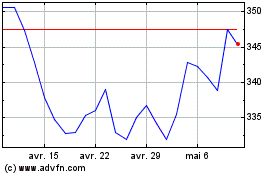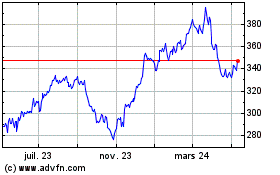By Sarah Nassauer and Jennifer Maloney
This article is being republished as part of our daily
reproduction of WSJ.com articles that also appeared in the U.S.
print edition of The Wall Street Journal (August 25, 2020).
Nearly six months into the coronavirus pandemic in the U.S.,
big-box retailers are emerging as business winners while
competitors -- including some apparel sellers and small businesses
-- struggle.
The big sellers' strength wasn't always a sure thing. Early in
the Covid-19 pandemic, while they had rising sales, they also had
rising costs and complications as they tried to keep workers and
customers safe and product moving.
But now, Walmart Inc., Home Depot Inc. and a handful of other
big retailers are delivering not only strong sales but also strong
profits. Last week, Target Corp. posted an 80% jump in earnings
from a year ago, while profit leapt 75% at Lowe's Cos. Amazon.com
Inc.'s profit doubled to a record $5.2 billion in its June
quarter.
Several factors tie their success together. These big companies
had already invested to build their online businesses and had cash
on hand to adjust to the pandemic. They were selling what people
were buying and had large supply networks they could tap to
eventually restock. In addition, most were deemed essential
retailers early in the pandemic and thus have largely remained
open.
When the coronavirus surfaced in the Raleigh-Durham area this
spring, Target stores were ready for the sharp increase in online
orders. Most had already allowed shoppers to pick up items in
parking lots. All had staffers in back rooms packing up orders.
"We had a lot of the infrastructure in place, and we just had to
ramp up, " said Je'Varis Richardson, a Target district manager who
oversees 13 stores in North Carolina.
Since February, Mr. Richardson's stores more than doubled the
number of staff focused on packing online orders. Red and white
signs were added to 50 more parking spots, designated as pickup
areas. That preparedness helped Target report a record jump in
quarterly sales and a 195% growth in digital sales.
Walmart, Amazon, Target, Home Depot, Lowe's and Costco Wholesale
Corp. accounted for 29.1% of all U.S. retail sales in the second
quarter, according to Craig Johnson, president of consulting firm
Customer Growth Partners, up from 25.6% in the same period a year
ago.
Investors will get another check of big-box retail's power when
electronics giant Best Buy Co. reports its latest results on
Tuesday.
Sales at smaller retailers fell 7% between March and mid-August
compared with the same period last year, according to Womply, a
data firm which tracks revenue at more than 70,000 small U.S.
retailers. Many smaller chains had to clamber to start taking
online orders or offer local delivery.
Carrie Tell, owner of a True Value Hardware store in Hopewell
Junction, N.Y., has also seen demand for her products surge as
shoppers spend more time at home, gardening and fixing things
around the house. But unlike the larger retailers, her store, which
has six full-time employees, wasn't ready for the e-commerce swell,
she said.
Ms. Tell had planned to start offering goods for sale online in
April, but the company she had booked to catalog her products to
list online canceled when the state went into lockdown. "It really
was exactly the moment when I could have used it," she said.
Her cashiers took curbside-delivery orders over the phone -- and
called customers back to complete their purchases. Ms. Tell offered
free local deliveries. Sales spiked but with the added labor costs,
store-sanitizing and delivery expenses during the pandemic, her
business is just slightly up compared with last year, she said.
Before the pandemic, Walmart, Target and many large retailers
had already spent heavily to build e-commerce warehouses, mobile
apps and delivery networks to compete with Amazon. Now they can
leapfrog smaller retailers or those in weaker financial situations,
such as department stores, said Matthew Hamory, a managing director
in the retail practice at consulting firm AlixPartners.
"We will see a sort of winnowing out of the folks who were
already structurally disadvantaged against the big box," he
said.
Big-box profits benefited from higher prices. Strong consumer
demand -- boosted by government stimulus checks -- and a shortage
of some goods lessened the pressure to offer discounts.
"It just doesn't make sense for a retailer to be aggressive with
the promotions right now," said Michael Lasser, a retail analyst at
UBS. The outsize sales gains at large chains have more than offset
higher expenses, such as wages and cleaning.
Many already weakened retailers such as department stores and
apparel retailers gave up more ground to their big-box competitors
amid forced closures, spending shifts and lagging e-commerce
capabilities. Since May, several chains have filed for bankruptcy
protection with plans to close many stores, including Lord &
Taylor, J.C. Penney Co. and Stage Stores Inc.
Meanwhile, apparel spending rose at big-box stores such as
Target and Walmart, which offer one-stop shopping, likely grabbing
business from floundering competitors, say retail analysts.
Both Target and Walmart faced online challenges early in the
pandemic as demand for household goods surged nationally. Walmart
reduced the number of pickup and delivery windows it offered in
March and April, instead using store workers to replace
out-of-stock products by unloading trucks and stocking shelves.
"That lasted for a few weeks, but the team recovered," Walmart
CEO Doug McMillon told analysts in June. Walmart has increased
store pickup and delivery slots by around 30% since February,
executives said last week. E-commerce sales rose 97% in the latest
quarter.
Target had planned to add fresh food to its pickup and drive-up
services in about half of stores this year, but paused that rollout
in March "given the severe swings we were seeing in store traffic
and the onslaught of new routines we are asking our store teams to
perform," said Target CEO Brian Cornell last week.
By May, Target rolled out the services at an accelerated pace
and is now offering them in 1,500 stores. Same-day pickup and
delivery sales rose 270% in the most recent quarter. Sales from
digital channels accounted for 17.2% of Target's total revenue for
the quarter, the highest percentage in company history.
Some shoppers are being trained to use these online services at
big-box retailers and won't go back to competitors, said Mr. Hamory
from AlixPartners. "That share may have permanently shifted to
bigger companies that were better able to capture it."
Suzanne Kapner contributed to this article.
Write to Sarah Nassauer at sarah.nassauer@wsj.com and Jennifer
Maloney at jennifer.maloney@wsj.com
(END) Dow Jones Newswires
August 25, 2020 02:47 ET (06:47 GMT)
Copyright (c) 2020 Dow Jones & Company, Inc.
Home Depot (NYSE:HD)
Graphique Historique de l'Action
De Mar 2024 à Avr 2024

Home Depot (NYSE:HD)
Graphique Historique de l'Action
De Avr 2023 à Avr 2024
